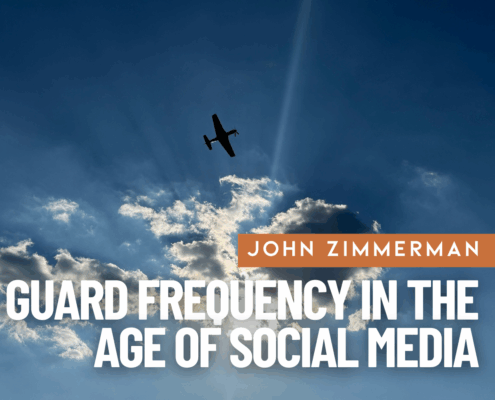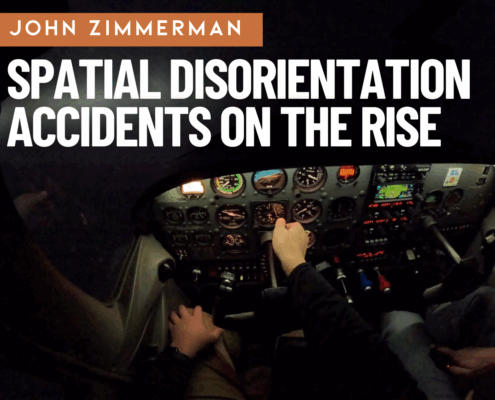
Go-arounds don’t have to be hard
John's blogI was grumpy with my friend because I hate the obsession with instant analysis, and he made me participate in this ugly trend. I was grumpy because this accident hit a little close to home, killing a father who was flying his wife and daughter in a Cirrus SR22 (something I do often). But I was mostly grumpy because go-around accidents happen far too often—and they are eminently preventable. This is one problem we should be able to solve.

Guard frequency in the age of social media
John's blogYes, this is an “old man yells at cloud” article. Yes, I can already hear the jokes about the “guard police.” I don’t care. It needs to be said: Guard frequency (121.5) has become a national embarrassment, a sign that our self-absorbed social media culture has spread to the once-boring world of aviation. We need to do better.

Why are spatial disorientation accidents on the rise?
John's blogResearchers from the FAA show that SD accidents have not declined since 2003—in fact, quite the opposite. You might assume the widespread adoption of tools like datalink weather, modern autopilots, reliable AHRS, and electronic flight bag apps would make VFR-into-IMC (the classic SD accident scenario) much less common. It’s a great theory, but the numbers don’t support it.

The aviation community is alive and well
John's blogBefore the expletive could even leave my mouth, one of the FBO employees offered to lend me the crew car. I assumed the crew car option would be impossible, or at least impossibly bad manners, since the round trip would be nearly two hours and the FBO was closing soon. But he wouldn’t hear it: “take all the time you need and just drop the keys off with the night security guard. We appreciate your business.”

The Starlink era is here—will we regret it?
John's blogThis promises to be a major advancement in cockpit technology, with benefits for pilots and passengers alike. But before diving headfirst into the Starlink pool, it would be wise to pause for just a moment and contemplate what we might lose. Don’t worry, I’m no Luddite and I’m not here to scare anyone away from an exciting new gadget. I am, however, an observer with enough experience to have seen technological breakthroughs bring unintended consequences. I fear that may happen here.

Pilot’s Bucket List: 11 Must-Do Adventures After Earning Your License
John's blogEveryone's dream list will vary, but let me suggest 11 things that every pilot should do with their license. Call it a bucket list if you want, but I consider it a flight plan for a fulfilling life in the cockpit.

Who is the pilot in command of your aircraft?
John's blogFAR 91.3 is one of the simplest and best known federal aviation regulations, and it clearly defines the most essential job as a pilot: to be the boss for the entire flight. But as obvious as this sounds, it’s surprisingly hard to do in the real world. Little by little, your authority as PIC can be eroded until no one is actually in command.

The pros and the cons: Cirrus SR22
John's blogCirrus had a controversial reputation early on, and to this day it’s the butt of some jokes. But it’s also the best selling piston airplane in the world for 20 years straight, a lone bright spot among small airplane companies who otherwise seem to be surviving on a few big flight school orders. And as I’ve repeatedly observed, the most vocal Cirrus critics are usually the ones who have never flown one.

Christmas reading list: 24 books for pilots to read in 2024
John's blogSix years after my last list, I still hate social media and I still love books, so I’m back with more recommendations—24 good aviation books for 2024. This is an eclectic mix, so I don’t expect readers to love every suggestion, but I believe there’s something for pilots to learn from almost any book, even if it doesn’t relate to aviation directly.

Weather flying means learning to read clouds
John's blogWhether I’m flying IFR or VFR, most weather decisions come down to looking at clouds and trying to figure out what they are trying to say. Is that weather convective or just harmless showers? Will the ride be bumpy or smooth? Can I top that cell? Is there ice in that cloud layer? The answer almost always depends on what the clouds look like.

What’s wrong with the teardrop pattern entry
John's blogHaving solved the impossible turn and other manufactured crises, the aviation training industry (or at least some YouTubers and keyboard warriors) has now turned its attention to the teardrop pattern entry. This “innovation” is alternately described as wildly unsafe or the only legal option for entering the traffic pattern. In reality it’s neither, but the bigger problem is that most pilots don’t even know what it means.

What matters for VFR proficiency: better landings
John's blogEarlier this year I argued that if IFR pilots wanted to prevent accidents, they should focus on the most boring of skills: basic attitude instrument flying. Now it’s time to look at VFR pilots, and to spare you the suspense, the answer is similarly prosaic: loss of control on landing damages more airplanes than any other accident scenario. What can be done?

Ignore the YouTube crash detectives—it’s usually pilot error
John's blogWhen a high performance airplane crashes in IMC, the self-proclaimed experts on social media quickly spin elaborate theories about autopilot failure, in-flight icing, structural failure, carbon monoxide poisoning, or some other incredibly rare cause. It makes for good entertainment (“hit that subscribe button!”) but the reality is usually much less interesting and much more depressing.

Why learning to fly can be good for your mental health
John's blogAmericans seem to be especially gloomy right now, according to a popular book and a report from the US Surgeon General. There are no miracle cures, but becoming a pilot can provide many of the positive experiences these experts recommend. No, I’m not suggesting the federal government mandate flight training to make American teenagers happy, but consider the following.

What a difference a decade makes: the GA boom in statistics
John's blogGeneral aviation is growing. That simple statement would have been unremarkable to a pilot in the 1960s or 1970s, as surprising as saying the sun rose in the east that day. But for anyone who learned to fly after about 1990, and especially between 2008 and 2016, it’s a shocking thing to admit. Yet that is exactly what is happening right now, as data from a wide variety of sources show.

What matters for IFR proficiency? The answer is quite simple.
John's blogAssuming you are busy and have to make hard choices about what to focus on, I think there’s a strong case to be made for spending your precious flying time on basic attitude instrument skills. Flying approaches to minimums or practicing emergencies may be more fun, but those procedures are not where pilots make the most fatal mistakes.

Pilots need to be generalists, not specialists
John's blogAmerican education has been obsessed with STEM (Science Technology Engineering and Math) for at least a decade, and the aviation industry has eagerly jumped on the bandwagon. The FAA is leading the charge to fit our square peg into this round hole, declaring aviation to be the ultimate STEM career path. I’m in favor of anything that attracts a new generation of pilots, but this framing is a radical oversimplification—and it sets up some pilots for failure.

TAFs are so last century—here are four new tools to try
John's blogIf your preflight weather briefing habits don’t change every few years, you probably aren’t curious enough. Occasionally there are major shifts, like the one from Flight Service phone calls to iPad app self-briefings, but more often we slowly integrate new weather resources and let others fade away. That’s exactly what I’ve done with the Terminal Aerodrome Forecast (TAF), the gold standard of aviation forecasts. I still read them, but it plays a much less central role in my decision-making process than it did five years ago.

Five changes the new MOSAIC rule could bring to aviation
John's blogThe word mosaic can be a noun, meaning a beautiful arrangement of glass, or an adjective, as in the tablets that Charlton Heston brought down from the mountain. Whether you view the FAA’s recently released Modernization of Special Airworthiness Certification (MOSAIC) proposal as a work of art or a restrictive set of commandments from on high, this 300-page document will definitely change general aviation.

What pilots can teach the world about AI
John's blogIn 2023, Covid has rapidly receded from the headlines, but now artificial intelligence (AI) is here to kill us. That’s according to many prominent voices in the computer science community, and more than a few traffic-chasing news outlets too. Once again, I believe pilots have relevant experience to share on this topic. In fact, how to manage technology has been the defining aviation debate of the last 50 years.
